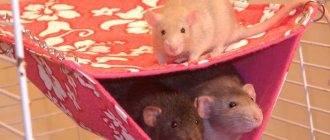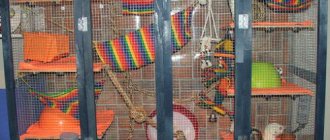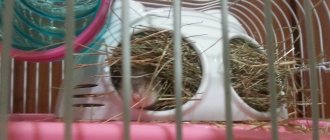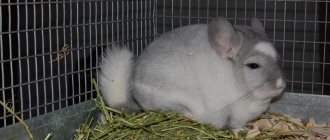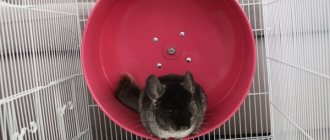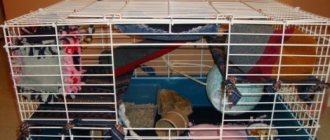- home
- Rat
- Care
06/08/2019 All pets, including decorative rodents such as rats, need a cozy home. If the owner wants his pet to feel comfortable, he must take care of a reliable and comfortable shelter. This article is about what a house for a rat should be like, and how to make it with your own hands.
Accessories for the cage - what should be there?
So that the rat has somewhere to hide, you need to come up with boxes for it. If nothing comes to mind, take plastic pots and convert them into houses. A rat must have such a secluded place: in nature, they hide from large predators, and if the animal is always “in full view,” this will make it nervous and aggressive.
To give her somewhere to climb, consider natural accessories. These can be wooden sticks from the store, but the easiest thing is to take a small branch on the street and put it in the cage: let him frolic to his health!
In nature, rats are quite active animals, so they need to have somewhere to run. Be sure to install a wheel in the cage: then excess weight and cardiovascular diseases will not occur even in the most voracious pet.
What else is needed?
- Food bowl made of ceramic, plastic or metal
- A drinking bowl with a special tube (it is screwed to the cage). However, not all owners can train their pet to drink from this device, so we recommend, just in case, to buy a second bowl - a regular one.
- Mineral stone - for feeding and grinding teeth
- Carrying - in case it is necessary to visit the veterinary clinic
- Clothes - if you decide to do a fun photo shoot for your pet
- Blocks of wood, special toys and/or “bones” for dogs - the rat will also gnaw them with pleasure, you’ll see!
- Other toys are up to your taste and budget. We will talk about them below.
What to make a house for a rat from?
Not happy with the option with pots? We agree, such a house does not look aesthetically pleasing. A more beautiful one can be bought in a store or made from other scrap materials. But, in any case, what is more important is not beauty, but safety. Therefore, you need to decide on the housing material:
wood - such a house will have to be changed often, since it absorbs liquids and odors. But, in general, this is a good option - safe, budget-friendly, environmentally friendly and beautiful:
- plywood - the disadvantages are the same as those of wood, and one more - the presence of glue in the composition, which is not safe for the health of your pet;
- cardboard is a delicacy; a rat will chew it up in a week. The conclusions are clear;
- hard plastic that a rat cannot chew is the best option - cheap, safe and durable.
Toys for the cage - what to buy for your pet’s leisure?
As you already know, rats are very active. But where to put energy in a confined space? Toys that you can buy at any pet store or make yourself come to the rescue:
- Swings and hanging rings that you can hold on to with your paws.
- Ladders that can be leaned against a shelf or against the wall of a cage.
- Suspension bridge. You can make it yourself - from ropes with knots tied at equal distances from each other, as well as from a bamboo mat - it will look like the real thing!
- Toy mechanical insects that your rat will love to hunt for.
- A garland of treats - just attach his favorite treats to the rope: let him climb up it and enjoy the taste!
- Bell on a chain. Please note that the constant noise from the cage can be annoying, so secure it so that it can be easily removed if necessary.
Why is it necessary to equip a cage house?
Some people think that houses are just a cute extra thing for a rat's cage, but in fact they are truly essential to the well-being of your pet rodent. In the wild, rats are the prey of predatory animals, so they dig holes for safety and protection, and at home, where they cannot burrow, shelter helps them feel safe.
There are also five other reasons to buy a rat house, including:
- Stress.
Fear can be one of the stressful situations. A pet rat can be frightened by loud barking from a dog, the voices of strangers, and similar loud noises. Then the rat can crawl into the house and feel safe. If your pet does not have a place to hide, then nervous tension may cause health problems. - Cold
. If the room temperature is low, the rat may need a place to stay warm. Rats usually insulate their house with whatever materials they can find. Also, several rats sleep in one shelter, keeping each other warm. - Draft.
Rats need a house with thick walls that will not allow cold air to pass through. After all, hypothermia can cause colds or more serious illnesses. - Age.
Older rats are much less active and prefer to spend more time in shelters. They also often have health problems, so they need to feel calm and safe. - Sunlight
. Rats are sensitive to direct sunlight and hot temperatures, so the house will be an excellent shelter for them from overheating.
Advice!
Place some treats in the new hiding place. Acceptable treats: apples, carrots, broccoli, tomatoes and bananas.
Option number 2: rat traps made of plastic bottles
The traditional version of this trap looks like this:
- The top part of the bottle is cut, it opens slightly, a long rod is attached to it, to which, in turn, a tourniquet is attached, which plays the role of a spring;
- Near the bottom of the bottle, through a hole in the wall, a trigger is attached, to which the bait is attached;
- The door from the neck of the bottle is attracted by a rope to the body of the bottle - this will allow it to slam shut when the animal pulls the bait.
Capture is simple: the rat climbs into the bottle, pulls the bait, and the rubber band slams the door. That's it, the animal is caught. The video shows how this design works and how to assemble it:
And here is another example of a simple but very effective rat trap, which you can easily make with your own hands from a plastic bottle:
- The bottle is strung on a rod (for example, on a thick wire);
- Then the outside of the bottle is coated with bait - sour cream, porridge, stew;
- The rod is placed on the edges of a bucket or barrel;
- A bridge made of boards is connected to the bottle.
A similar design can be made from a bucket and a beer can. The photo below shows a corresponding example:
The disadvantage of rat traps with a rotating bottle (or jar) is that they are bulky - it is not always convenient to use them at home.
It’s easier with mice - for lovers of beautiful solutions, a compact mousetrap made from a plastic bottle has been invented, which, if desired, can be placed under a table or in a closet. The following video shows how to assemble such a trap from available materials:
The main thing in this design is to correctly guess the center of gravity of the bottle.
If you take a suitable bottle, you can use it to make a rat trap using the same principle.
It is only important to keep in mind that, given enough time, the animal may try to chew through the walls of the trap and thereby get out of it.
What is it needed for
Does a rat really need a house? Experts insist that the animal must have its own secluded corner. Let's try to figure out the reasons.
First of all, it is necessary to note the stressful situations that can happen to an animal due to many factors. A stranger, loud noises, sudden movements - all this can frighten the animal, and it will want to hide.
In the absence of such an opportunity, even tame rats can experience attacks of aggression and panic, which in severe cases lead to health problems.
While providing comfortable conditions for a pet, owners need to take care that the cage is not exposed to drafts. Rats can be very sensitive to them and often get colds. A house with windproof walls will allow you to hide inside and not get sick. Also, in an insulated house you can easily hide from the cold, even in an apartment where, for some reason, the temperature is quite low. If direct sunlight hits the cage, rats, on the contrary, can hide in a shelter from the heat.
The rat feels safe in the shelter . This is especially important if the animal is not feeling well. Calmer males feel much more comfortable without a house, while girls, on the contrary, need protection and a secluded corner.
Hammocks for rats
Rats love hammocks! This is a great place to relax. There are many ways to make them yourself. Here are some simple ideas:
- Ordinary hammock.
Cut off one leg of old jeans (select the length based on the size of the cage), pass two ropes through it and tie the resulting hammock in a rat cage. You can use an old face towel or cut a piece of thick fabric to size, make a hole in each corner, thread string or string through it, and tie it to the bars of the cage. The hammock can be attached to the bars of the cage and using large pins or shower curtain hooks - this will allow you to quickly and easily remove the hammock for washing. - Hammock with pocket.
Cut a piece of thick fabric to the required dimensions. Fold it so that the top covers 3/4 of the bottom. Sew up the sides. Attach the hammock to the cage using ropes or hooks. Rats will be able to relax on the hammock on top or burrow into a pocket if they get cold. This hammock with a pocket is ideal in winter, especially if it is made of warm fleece. - Hammock.
Cut two identical pins from wood and insert them between the bars of the cage at the same level. You will end up with something that looks like a bird's perch. Cut a suitable size pant leg from old jeans (you can use other thick fabric) and sew along the edges. Now stretch the fabric over the wooden dowels. You should now have a hanging bunk. The fabric should not be too stretched, but should sag a little. - Attics.
Cut the leg of your old jeans to the required size. Thread two pieces of rope through the cut piece and tie them relatively close together to the bars of the cage, so that the pant leg piece is pulled up at the top and down at the bottom. You should end up with a triangle with the base at the top that your rats can crawl into. Alternatively, you can make four holes in the top of the denim leg and tie them to the bars of the cage with string. To create even more comfort for your pets, you can close the “loft” on one side. - Soft descent.
Cut a piece of thick fabric and tie it well to the high and low shelves. There should be a soft descent from floor to floor. Your rats will climb up it and smoothly slide down. It will be a good alternative to stairs or ramps. - Rat bag.
Cut a piece of thick fabric to the required dimensions. Fold it so that the top covers 3/4 of the bottom. Sew up the sides. It is better to make the upper part a little wider (trapezoid), so after sewing the sides, the resulting bag will always be slightly open. Attach the top two corners of the rat pouch to the cage using ropes or hooks. Rats will be able to climb into a hanging bag and rest quietly in it, hidden from prying eyes. - Cozy pouch.
Such products can be sewn from thick fabric or fleece, or you can simply use a small old bag. Place the finished bag on the floor of the cage and secure its upper edge with a hook or rope so that the entrance is always open. It is better to place such cozy bags under stairs and ramps. Your pets will love to sleep, play or fight inside them.
When you do, make two. A spare hammock will always come in handy when the first one is in the wash or gets torn to shreds.
What to equip
Rats are very energetic animals; structures for climbing and other active games must be placed in the house: ladders, shelves, tunnels. Unlike their other rodent brethren, they are indifferent to the spinning wheel and are not worth purchasing.
First of all, build a “nest”; an ordinary cardboard box with a drilled hole will do for its manufacture. In such a shelter, your tailed friend will feel comfortable and safe, relax and sleep. Place paper and small rags on the bottom; they will be used for home improvement. If you want to please your pet, buy a nest in the form of a ball, hanging basket or hammock; rats love them very much.
How to make it yourself?
It is not necessary to purchase a ready-made hammock for your pet at a pet store. Store-bought products are not always of good quality and reasonable price. From available materials you can make a good and reliable model of the required size. During production, a number of recommendations should be taken into account.
- There is no need to try to save free space in the cage and make a bed that is too compact. It is better if the hammock is 2 or more times wider than a rodent.
- It is best to use metal objects, such as paper clips and chains, as fasteners for the product. Such fastenings will be more reliable than a simple rope, which a rat can easily chew through.
- The fabric from which the hammock will be made must not only be durable, but also safe from a toxic point of view. If it was painted with harmful dyes, then the pet may get poisoned. It is best to use natural types of fabrics rather than synthetics.
- Metal parts can only be used as fasteners, but not as the main canvas for the bed. A metal mesh is stronger than fabric; an animal is unlikely to chew through it and ruin it, but it can injure the pet. In addition, metal is too hard and cold material, so the rodent will be uncomfortable and uncomfortable on such a hammock.
From jeans
Using old denim clothes is one of the easiest ways to make a hammock for rats. In this case, you don’t even need to pick up a needle, thread and sew. All you need to make a hammock is:
- unnecessary jeans;
- stationery scissors;
- ruler or measuring tape;
- a small piece of old soap;
- metal chain or paper clips.
It will take no more than 10 minutes to make a denim bed. It is best to use old wide men's jeans. You need to measure 25 centimeters from the bottom edge of the trouser leg and mark the cut with a bar of soap. Then you need to cut a piece from the trouser leg and start making fasteners.
The number of staples in the chain will depend on the height at which you plan to hang the hammock. The materials used must be quite strong so that the fasteners can withstand the weight of the decorative rat. Chains or staples are threaded through one layer of jeans at the four corners of the cut piece. After this, you can place the bed in the cage and attach it to the metal bars. The rodent can be placed on the lounger either on top or inside the trouser leg itself.
Out of the hood
You can convert a hood from an unnecessary item into a hammock for a rodent. In this case, the process will take a little more time and effort than when making a denim couch. In addition to the hood itself, you should first prepare the following things:
- stationery scissors;
- sewing machine or regular needle and thread;
- large diameter metal wire that will serve as a frame.
If the hood was originally attached to a sweater or jacket with a zipper, then it must be cut off. To create a hole for the wire, the uneven edge must be bent 1-1.5 centimeters and stitched well. A metal wire is inserted into the hole, after which the edges need to be sewn up. A canopy hammock is usually made in the shape of a bag. To do this, the edges of the hood, which were located closer to the face, are sewn together. The finished product can be attached to the cage using sewn ties made of thick rope or on a chain of paper clips.
From a piece of fabric
To make a hammock, you can use a single piece of fabric. You can purchase it at the store or use old unnecessary things. For example, you can fold a pillowcase, sheet or towel several times and sew up the edges. If the material will be purchased in a store, it is best to buy fleece or cotton fabric. The size of the piece of fabric must be selected in accordance with the dimensions of the cage and the animal. As a standard, you can use a canvas of 30x60 centimeters. In addition to the hammock base, you will need the following things:
- needle and thick threads;
- stationery scissors;
- fittings (eyelet with washer) for edging holes;
- a hammer or special pliers and a hole punch for installing eyelets;
- hooks designed for shower curtains in the bathroom.
From the two narrowest sides of the rectangular piece you need to fold 1 centimeter of fabric and sew up the folds. The stitched ends need to be connected to each other in the center of a piece of fleece or other material. Next you need to sew the long edges. The resulting fabric must be turned inside out through the hole in the center.
You need to install eyelets in the four corners of the piece of fabric. Then hooks are inserted into the holes reinforced with fittings, after which the hammock can be hung in the rodent cage.
The easiest way to create a home for a rat
No matter how paradoxical it may be, the easiest way to make a house is using the papier-mâché technique. The design can have any shape, size, color. The set of materials and tools is minimal: a mold for the product, a roll of toilet paper or a pack of napkins, water, a brush and a little time.
How to make a house for a rat with your own hands using the papier-mâché technique?
- Install the prepared form.
- Tear napkins or toilet paper into thin strips.
- Lightly moisten the strips of paper in water and place them on the prepared form.
- You need to make sure that the shape is not visible through the paper, and that the cellulose layer is sufficient to hold the shape.
The paper will dry within 24 hours. Then you should carefully remove the form, you will get a wonderful house. You can use a utility knife to cut holes for windows and entrances. If desired, you can paint your home with safe paints.
Accessories for the cage
When caring, you need to think about the physical and mental health of your pets.
Rats are intellectually developed creatures. They need toys, hammocks to sleep in, places to wait out danger, and materials to sharpen their teeth. Toys and objects for incisors need to be changed frequently, otherwise your pets will get bored with them.
When choosing a wheel-style treadmill, make sure it is large enough for your rat, but does not take up too much space in the cage. Buying a cardio wheel is not a requirement. As rodents grow up, they lose interest in running on wheels.
There should be a solid and heavy container for food in the cage, and a drinking bowl with at least 0.5 liters of water should be hung between the bars.
Methods for finishing finished pet houses
It’s not enough to make a house for a rat with your own hands, you also need to decorate your pet’s home. This technique will give the cell an unusual look. It will seem that the cage is a separate dwelling, a house within a house.
Photos of houses for rats, made by hand by some craftsmen, are stunning in their appearance. You can find entire castles, huts, and villas. This effect can be achieved through decorative design.
The home can be painted, burned, or covered with thread or fabric. Attach rat toys to the walls or secure rings for them to run into.
DIY making
So, it was decided to make a house for the rat with our own hands. When choosing a material, owners often opt for plywood. It is quite durable; the surface, unlike wood, does not require heat treatment. In addition, working with plywood does not require special skills and anyone can handle it.
First of all, you need to figure out what the animal’s home will look like, decide on its size and design
The location and methods of attachment in the cage are also important. Next, measurements and a schematic drawing are made that will help in the work.
The necessary parts are made using a jigsaw.
Experts recommend thinking about ventilation. This means that, in addition to the entrance, you need to make a couple more small holes that will help air circulation.
Animal feces inevitably lead to unpleasant odors. To minimize this problem, you can make a house for your pet without a bottom. Such a structure is placed directly on the floor of the cage. The roof can be protected using plastic elements attached to it.
It should be borne in mind that when making a house it is not recommended to use glue, varnish, impregnations and paint. These materials may be toxic. In addition, the pet will definitely chew its home, and these substances can lead to its poisoning.
Plywood is an excellent option for making a rat house. However, let’s look at how you can make a pet’s home from other materials, the advantages and disadvantages of each of them.
From cardboard
This option for making a rat house is the simplest and does not require financial costs. A box of equipment, shoes or food is perfect as a base. In addition, cardboard is absolutely safe and will not harm your pet.
Among the disadvantages, it should be noted that such houses have a very short service life. Cardboard gets dirty very quickly, becomes deformed and begins to smell unpleasant, which means it will need to be replaced every few days.
From a plastic container
Plastic is a non-toxic material, moreover, it is easy to clean and does not absorb odors. Accordingly, a house made from a food container can serve your pet for a long time. In addition, the material is quite dense, and the rodent will not get hurt on it during the grinding of teeth. Food containers are often opaque, which is an added benefit since rats like to be in the dark and may not feel very comfortable in bright light.
The manufacturing principle is simple. You need to take a container and cut an entrance hole for your pet in it, and cover the edges with electrical tape if necessary.
From a plastic bottle
In this situation, you will need available materials. First of all, a plastic bottle, which is found in almost every home. Containers made from milk, kvass or mineral water are suitable. In addition, you will need an old and unnecessary jacket made of soft material; you need to cut off the sleeves from it.
To make a house, the neck of the bottle is cut off. There are sharp and not very smooth edges that can injure animals, so you will need to cover them with tape or tape. Also, the sleeves of the sweater are attached to the tape both inside and outside the house. It must be remembered that the use of glue is highly undesirable, since its toxicity can be harmful to the rat.
Made of wood
Experts believe that it is best to make a house for a rat from wood. There are several advantages, the main one is environmental safety for the pet. The animal will also be able to grind its teeth on the body.
The choice of material must be approached carefully, because not all types of trees can be used. Some of them may also be harmful to your pet’s health.
It is recommended to choose fruit crops such as rowan, apple and pear. Birch, oak and linden houses will not harm the rodent.
It must be taken into account that the material must undergo heat treatment, which is designed to help get rid of possible parasites. To do this, place it in a hot oven for 2–3 minutes. The temperature should be 100 degrees.
One cannot help but mention the disadvantages, the main one of which is the ability of wood to absorb moisture. Rat waste can cause serious damage to it, and the smell will be corresponding. The house will need to be thoroughly cleaned and periodically replaced with a new one.
You can learn how to make a three-story house for a rat with your own hands by watching the video below.
Which house is better to choose?
Decorative rats are large species of rodents. When choosing a house, you must first of all focus on size. Minimum dimensions: 250x150x100 mm. Little rats need a smaller structure. It is necessary to ensure that the fast-growing rodent does not get stuck in the opening of the temporary shelter that has become small.
When choosing a house you need to be guided by the following principles:
- Environmental friendliness and safety. The rat tries everything it comes across.
- There are no sharp or protruding corners that could injure your pet.
- The walls must be opaque.
- The window should not be in line with the entrance.
- The design must be breathable and at the same time protected from drafts.
If the shelter is chosen correctly, the pet will immediately appreciate it.
What to do with a rat trap and a caught rat
Of course, a person is no longer a medieval barbarian, but in relation to a caught rat, there is only one solution - liquidation. This can be done as follows:
- add water to the container so that the animal drowns;
- a precise blow to the head with something like a bat;
- shoot the pest if you have a suitable weapon;
- if it is possible to transfer the animal into a sealed container, you can send the “criminal” to the gas chamber. Mix soda and vinegar in a cup, pour into a container, the animal will suffocate (this is considered a humane method of punishment).
The methods described seem terrible, but a person cannot, like the Pied Piper of Hamelin, control animals with a pipe, so there are simple methods of elimination.
Secrets of experienced house makers
Before making a house for a rat, it is worth considering several features of certain parameters:
- the height of the structure should be such that the rat cannot reach the ceiling while standing on its hind legs;
- the width and length of the room are made such that the rat can freely fit in a lying position;
- The entrance should be wide, but not too wide, the pet should pass through unhindered, and the person should be able to easily clean inside.
Other recommendations may relate to the type of material (we mentioned this above). As you can see, making a home for a small rodent with your own hands is not only easy, but also interesting.
Features of making fabric with your own hands
The hammock will get dirty during use, so it must be washed regularly. Sometimes a rat begins to chew the cradle or use it as a toilet, which reduces the service life of the product, so after certain intervals the old hammock will have to be thrown away and replaced with a new one. In order to save money, it is better to sew a new cradle yourself, since the necessary materials and accessories will cost much less than a ready-made store product.
Did you know? In a year, an adult rat eats about 12 kg of food. Strong teeth allow these animals to gnaw through even such strong materials as iron and concrete.
Selection of material and necessary tools
A rat hammock can be made from any soft fabric you have on hand. The material often used is old jeans, unwanted bed linen or terry towels. Patterns of appropriate sizes and shapes are made from the selected fabric, and then sewn together by hand or using a sewing machine.
In addition to fabric, to make your own cradle you will need the following tools and materials:
- scissors;
- ruler;
- round pattern;
- sewing pins;
- needle and thread;
- a piece of chalk;
- pieces of tape (for tying to the roof of the cage).
Step-by-step instruction
To sew a simple and beautiful hammock for your pet rat yourself, you don’t need any special knowledge. Just take a few colorful pieces of soft fabric and spend a little time creating a cozy cradle for your pet.
Find out also what to feed and how to care for a decorative rat.
Step-by-step instructions:
- Prepare two pieces of fabric. Stack them on top of each other, straightening out all the folds on a flat surface.
- Using a ruler and chalk, mark the desired dimensions of the square hammock on the top flap.
- Insert sewing pins into the corners of the intended square to secure the top and bottom layers of fabric together.
- Cut out a square along the marked boundaries. Using a template, draw identical arcs on each side so that they do not reach the corners of the cut out figure.
- Cut the fabric along the marked arcs. Remove the pins connecting the top and bottom flaps.
- Prepare 4 ribbons approximately 30 cm long. Fold them in half and then secure them between pieces of fabric (two ribbons on two opposite sides of the figure), leaving the ends free.
- Sew the edges of the top and bottom flaps. Tie the resulting product to the walls and roof of the cage using the free ends of the tapes.
Interesting ideas for houses made from scrap materials
If you don’t have a lot of time or special desire to make a home for your pet, then you can use improvised devices. The process will take a few minutes, and you may only need a utility knife to make it.
You can make a house for a rat with your own hands using improvised tools in a few minutes like this:
- A plastic food tray will make a wonderful house; just cut out a passage and several windows in the walls of the dish;
- if you have the remains of Lego at home, then in a few minutes you can build a comfortable “villa” for your pet;
- an old parcel box is a simple and environmentally friendly option for building a home;
- a clay pot or an old cup laid on its side is an original option that will appeal to the rodent and the person who will clean the house.
Depending on the shape and size, it is easy to select other options for construction: a chandelier shade, a vase, a teapot, a small teapot, and so on.
Cons of decorative rats
Before you bring a little rat into your home, think about whether you are ready to accept him with all his shortcomings. The amount of responsibility does not depend on the size of the pet
Pay attention to the disadvantages of decorative rats
Short life expectancy
On average, rats live 2-2.5 years. With good care and heredity - 3-3.5 years, no longer. Parting with a smart and affectionate pet is unbearably difficult. This is the main disadvantage of rats - they live only a little longer than hamsters. But the owner usually does not develop a deep emotional attachment. Other rodents and lagomorphs - rabbits, guinea pigs, chinchillas and degus - live much longer than rats.
Rat "Siamese" color
Urine marks, feces
Although rats themselves are clean animals, they cannot be toilet trained like a cat or hamster. Peeing everywhere is necessary for them, this is how they mark their territory. I'm not sure about feces, but they poop wherever they want. Accordingly, after a walk you need to remove the “gifts”. When a rat crawls over a person, it can mark him too (pee).
Destroy things and repair
Call Captain Obvious, rodents are gnawing! Rats have incredibly strong and sharp teeth, allowing them to crush even concrete. Keeping smart animals in a cage all the time is cruel; they have to be let out to run around. And some damage is inevitable. Before a walk, you need to hide all things dear to your heart - documents, headphones. Rats chew curtains, wallpaper, books. My rat secretly chewed a round hole in the wooden bottom of the sofa, and made a luxurious nest in the quilted blanket that lay inside. I discovered this only in winter, but I was still surprised - where is he hiding for so long?
You need to decide in advance what you love more: rats or furniture
Poor health
Stories about the incredible vitality of rats cause them a lot of harm. People think that rats are “unkillable”, which means they can be fed everything, parachuted from a bunk bed, or allowed to swim in the bathtub. Firstly, you cannot compare the health of a wild pasyuk and a decorative rat. Secondly, the vitality of rats is primarily the well-being of the entire species, and not the individual. They have gained a formidable reputation for their extremely rapid reproduction. And fertility does not mean good health, rather the opposite. Rats catch colds easily, may suffer from digestive disorders, and get injured while walking. But the main thing is that they are susceptible to cancer. Their tumors grow rapidly and require immediate surgical intervention. The situation is complicated by the fact that only a small number of veterinarians are able and willing to treat rats. There is not a special doctor - a rodentologist - in every city. It is better to find out his contacts in advance from rat breeders or on rat breeding forums.
Read about how to properly feed a rat HERE (link will open in a new tab)
Curly mustache of a rex rat with wavy fur
May be noisy at night
In nature, rats are active at dusk and at night. Domestic rats often adjust their routine to suit humans, but still tend to be active at night. They can chew the metal bars of the cage and household items in it, and dig into the bedding. Consider this point - if the slightest noise prevents you from falling asleep, there is no place for a cage with rats in the bedroom. But children are usually not bothered by this night fuss, and they sleep peacefully next to their favorite pets.
The smell from the animal and from the cage
Many people even consider the smell from a clean and healthy rat to be pleasant. But in order not to smell the unpleasant smell from the cage, you will have to work hard. It is necessary to choose a good filler and change it regularly. Wash and clean the cage. Remove leftover food. The more rats, the more often cleaning is required. In addition, rats can piggy - scatter food and litter around the cage.
For most rat breeders, the animals walk freely around the room, returning to the cage at will. The larger the cell, the less likely it is that an unpleasant odor will occur.
Negative attitude of others
You should be prepared for the fact that some of your friends will stop visiting your home because you keep rats. Some people cannot stand their appearance, experiencing a feeling of disgust or fear. A phobia can be causeless and innate, like the fear of spiders. Or it may be associated with a traumatic experience of communicating with wild rats. My grandmother had one, and although she admitted that my pet had a cute face, she could not see his tail without shuddering. You can't force other people to like rats. Most likely, you will encounter cruelty and misunderstanding during the illness or death of a pet (“it’s just a rat”). You will also listen to lectures on the plague and other horrors associated with rats.
Plague on your home! Rat tails can be terrifying
Results
When the cage is small, this is not a reason not to give your pet a house. You can also attach it outside. They remove one of the doors, and attach the house to this place close to the wall. The second option is to hang a hammock. It takes up very little space.
When the rat is completely tame, the cage does not close; the house can simply be placed next to it. The important thing for a pet is that it has its own shelter.
Decorative rats have captured the hearts of many pet lovers. These are very smart, inquisitive animals with their own character and habits, and the owners try to make their maintenance as comfortable as possible. One of the conditions for this is that the animal has its own house. How to choose the right one or make it yourself – we’ll talk in our article.
How to make toys for rats?
Of course, such a complex will not only allow the rats to have a great time running around in the open space, but will also entertain your children, who will be happy to watch these ups and downs.
Take a spacious box and cut off its top cover. Don't throw this part away. You will cut strips from it. Then, using tape, attach these strips to the floor of the box so that a kind of labyrinth is formed.
Take a large strip and bend it, then you can glue the fabric on top here so that this blank turns into a rat’s house. In the photo it is green.
Now you can bring your pet here and watch how it runs through the maze in search of a house. You can put a little food in some areas to train the rat in this way. But everything must be done in moderation. And if you see that the animal is tired, return it to a regular cage.
See what other toys you can make for rats.
If you have polypropylene pipes and adapters for them, then create such an intricate labyrinth. But you definitely need to make holes in it for air access. When you make such a maze for rats, it is better to place the adapters in such a way that they shorten long sections. So that the animal does not get lost in this maze and does not get scared.
Rodents like toys made from natural materials. To make the next one, all you need is:
Take the log. If it is long, cut it off. Now take a drill with a round attachment and make 2 holes in it. Then, using a hammer and chisel or using special tools, select the middle of this workpiece.
Now all that remains is to secure the metal fasteners on both sides, and the toy for the rat is ready.
You can use strong wire to entertain rodents. Wrap a rope around it and secure it on both sides of the cage.
This and other rodents are sure to love your next rat toy. Make a triangular house like this from plywood. Screw the wooden dowels here from the outside and insert them into the pre-made holes. Glue them here. The rodent will climb such a steep wall and exercise.
Toys for rats can even be made from scrap materials. It is known that rodents love to grind soft materials with their teeth. Take toilet paper and place it near your pet's cage. It will pull the roll and soon you will see it shredding it.
You can let a rat into a spacious dollhouse. There will be a crib and wardrobes here. Your child will surely enjoy playing in this environment.
Here's another example of how to make toys for rats. Take wooden logs, you need to make a semicircular hole in the bottom of each so that rodents can run through here.
You can make a house out of papier-mâché. It will make a great toy. But do not use PVA glue, as over time the rat will probably get a taste of this house.
First, take toilet paper, soak it in water and squeeze out the excess liquid. Then grind this mass using a blender and add pre-boiled and cooled flour or potato paste.
Then start spreading this mixture onto a large rubber or leather ball. About halfway and a little lower. Leave a hole in the middle uncovered. Leave your creation to dry completely for one or two days, after which you can introduce a rat here. This will be a great toy that your animal will enjoy chewing on.
Here are some games you can offer your little rats and watch them have fun.
Place the peas in a bowl and add some water. Put all this in front of your animals. They will fish peas out of the water and make you laugh at the same time.
You can make a special piñata for rats. Take paper towels and fold them together. Pour dry corn seeds, sunflower peas inside, you can add cereals and other delicacies. Roll it all up, tie it and hang it on top of the cage. The rat will first sniff this package, and over time it will understand that there is a treat inside and will try to get to it.
You can also make these toys for rats. Take the wire and cut it into two pieces. You can use another round object. Now cut a strip of thick fabric, sew on the large sides, fold both sides and hem here. You will need to insert a wire on these two sides and secure it.
Another entertainment for rodents looks like this. Take a plastic or cardboard box. Place here crumpled newspapers, pieces of fabric, wine corks, leaves from unnecessary books and magazines. You can also add nuts and cereal here. Your pets will be happy to dig into this box, exercise in this way and have an interesting time.
You can create your own rat town from unwanted cardboard boxes.
Then you will need to cut holes in them and use wide adhesive tape or electrical tape to glue these elements together. Make tunnels here from plastic bottles. You can make ladders from ropes. If you wish, cut the denim into strips, twist them and make a ladder from this material. You can also borrow this item from parrots. Bridges can also be easily made from fabric, rope or wood. Make windows here too. Place small balls, pieces of fabric, and paper in this town. Your animals will be happy to have fun here and make you happy.
You can make bags from scraps of denim fabric. Fill them with grain, corn, peas, and sew up the hole. If you need to take your rat to the vet in winter, then this bag will come in handy. Heat it in the microwave or on a radiator. And the grains will keep warm for a long time, and the animal will not freeze at this time.
And if it's your pet rat's birthday, pamper him with a real cake. But make it banana based. Do not add butter to the dough; add nuts and seeds here. Bake a cake based on this fruit. Then melt the cheese, pour it over the dessert, and sprinkle sunflower seeds on top.
Here's how to decorate a cage for rodents, make entertainment and houses for them. It's interesting to watch the process of making such things. See how to make a house for a rat with up to 4 floors!
And in the second video you will see how to arrange a cage for this animal.
How to choose - main varieties
The decorative rat is a rather large animal, so the house must first of all be spacious. For an adult, the dimensions of the shelter should not be less than 25x15x10cm. For the first months, a smaller device is often installed so that the little rat feels more comfortable. But temporary shelters very quickly become “small” and the animal may one day literally get stuck in the doorway. Such an adventure will greatly frighten the animal and can also lead to physical injury, so it is important to replace the house with a suitable one in time.
Modern pet stores offer a wide variety of houses for rats - you will find many designs and shapes, from simple to real palaces with original design. When choosing, the material of the product is also of great importance.
Made of plastic
Convenient and practical devices, easy to clean, have fastenings that are convenient to hook onto the bars of the cage. But you need to take into account that in such a shelter the animal can be hot and stuffy in the summer.
Made of wood
More suitable for rodents, giving the opportunity to grind teeth. But wooden walls absorb urine and odors well, so the device will require replacement fairly quickly.
Wicker
Lightweight temporary houses, usually round in shape. They are made from tree bark, flexible twigs and hay. Animals love such houses very much, but they quickly become unusable.
Ceramic
A good option, such a house will be cool in the summer, will not lead to air stagnation, and special treatment will protect the surface from contamination. The downside is fragility - a ceramic product can easily be broken due to negligence.
Soft
An unusual shelter made of thick fabric, which is also often hung and used as a hammock. Such products can be washed, but they still do not last very long - the rat will definitely gnaw on the soft walls.
IMPORTANT: If there is not much space in the cage, the house can be installed outside. To do this, remove one of the lattice doors, the device is attached to the resulting opening using wire.
The shelter can also be installed on the roof. If the animal is completely tame and you do not close the cage door, the house can be placed or hung next to it - on a closet or on the wall; fabric products are well suited for this.
Despite the large selection of models, some owners decide to make a rat house with their own hands. This allows you not only to take into account all the peculiarities of the conditions in a particular cell, but also to realize your own unusual ideas.


